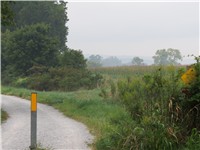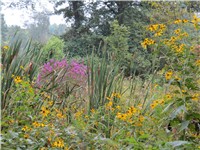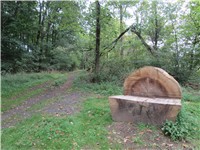Look for the start of the Lansdown Trail just to the right of Fox Lumber Company, easily identifiable by a crushed stone path leaving the parking lot. Follow this path along the side of lumber company, which at one time was the train station for this spur of the Lehigh Valley Railroad. An interpretive sign on the left outlines the interesting history of the railway.
...
Hike Description:
Look for the start of the Lansdown Trail just to the right of Fox Lumber Company, easily identifiable by a crushed stone path leaving the parking lot. Follow this path along the side of lumber company, which at one time was the train station for this spur of the Lehigh Valley Railroad. An interpretive sign on the left outlines the interesting history of the railway.
 After a short distance, pass under I-78 then cross a bridge. Don’t be discouraged by the sound of zooming traffic. This will soon fade away and be replaced by the sound of flowing water. About a quarter of a mile into the hike, the trail meets up with the South Branch of the Raritan River on the left. A little farther along, cross a paved road to an open view of the countryside to the right.
After a short distance, pass under I-78 then cross a bridge. Don’t be discouraged by the sound of zooming traffic. This will soon fade away and be replaced by the sound of flowing water. About a quarter of a mile into the hike, the trail meets up with the South Branch of the Raritan River on the left. A little farther along, cross a paved road to an open view of the countryside to the right.
After crossing three more bridges and noticing piles of old railroad ties along the side of the trail, the Lansdown Trail comes to an end at a kiosk and pullout parking on Lower Lansdown Road. You have hiked 1.8 miles to this point. There are two ways to connect to the Capoolong Trail. Turn right on Lower Lansdown Road avoiding the very overgrown rail bed that continues straight ahead. After a few steps another overgrown rail bed leaves to the left. There is a path through and over the old railroad ties that still lie in place but if you want to avoid the overgrowth, continue walking along paved Lower Lansdown Road. A short distance ahead at the intersection, turn left on Lansdown Road. You will arrive at the same live railroad crossing as the overgrown rail bed.
 Cross the live tracks and note the blue historical sign on the left. To the right just before the street signs, a footpath leaves the road – this is the Capoolong Trail although there is no sign. This trail, although well defined, will alternate between a wide cinder railbed and a narrow dirt footpath as it winds along the scenic Capoolong Creek.
Cross the live tracks and note the blue historical sign on the left. To the right just before the street signs, a footpath leaves the road – this is the Capoolong Trail although there is no sign. This trail, although well defined, will alternate between a wide cinder railbed and a narrow dirt footpath as it winds along the scenic Capoolong Creek.
At the 2.5-mile point, cross Lansdown Road and Sidney Road towards an interpretive sign where the trail continues. At 2.7 miles, turn right onto Lower Kingstown Road towards the bridge. The trail turns left before the bridge that someone has adorned with American flags and hanging plants. There is a gravel road with a “Private Drive” sign; proceed on the path to the left of that gravel road which will run a level higher. In 0.2 mile, the path and gravel road merge together briefly, then come out at a paved fork in a power cut. You might see some cattle grazing in the power cut to the left. Keep right on the paved road and turn right to pick up the trail just before the “Wrong Way” sign.
 At the 3.6-mile point, cross Lower Kingstown Road again at a large red barn then in a quarter of a mile come out on Lower Kingstown Road once more, turn right and head towards the Lower and Upper Kingstown Road signs with the one-lane bridge on your right, cross Upper Kingstown Road and pick up trail at an interesting bench cut out of a huge tree trunk. NOTE: The trail from Upper Kingtown Road to White Bridge Road has been officially closed by the DEP due to hazardous trail conditions resulting from washouts and erosion.
At the 3.6-mile point, cross Lower Kingstown Road again at a large red barn then in a quarter of a mile come out on Lower Kingstown Road once more, turn right and head towards the Lower and Upper Kingstown Road signs with the one-lane bridge on your right, cross Upper Kingstown Road and pick up trail at an interesting bench cut out of a huge tree trunk. NOTE: The trail from Upper Kingtown Road to White Bridge Road has been officially closed by the DEP due to hazardous trail conditions resulting from washouts and erosion.
At 4.6 miles into the hike, turn right on White Bridge Road and follow the road briefly. When White Bridge Road turns right, continue straight through a small gravel parking pad to once again pick up the trail that almost immediately crosses over a footbridge.
At 5.3 miles, cross a gravel road. Then, in another 500 feet, you'll notice the former train station (now in a dilapidated condition) on the right This is the end of the hike. Although there is a bridge across the stream a short distance ahead, this is a private bridge which is not open to hikers. Turn around and retrace your steps, either 0.7 mile to the second car at White Bridge Road, or all the way back to Clinton.
Click here for more pictures of this hike.
Turn By Turn Description:
[ 0.00] Walk towards Fox Lumber keeping to the right of the parking lot to the trail head
[ 0.25] Cross bridge
[ 0.35] Cross paved road
[ 0.50] 1/2 mile marker
[ 1.15] Cross bridge then power cut then another bridge
[ 1.55] Cross bridge
[ 1.70] End of Lansdown Trail; either cross Lower Lansdown Road and veer right then left on unmaintained rail bed (not the unmaintained bed straight ahead, the one to the right of that) OR turn right on Lower Lansdown Road to intersection, left on Lansdown Road to live tracks
[ 1.85] Cross live tracks then turn right on Capoolong Creek Trail (not marked) just before the Lansdown and Sidney School Road signs
[ 2.45] Cross Lansdown and Sydney slightly to the left
[ 2.70] Veer right on Lower Kingstown Road briefly towards bridge, turn left before bridge - trail runs parallel to the left of the private drive
[ 2.90] Trail merges together with gravel private drive and comes out at paved fork in power cut; keep right and pick up the trail to the right just before the "Wrong Way" sign
[ 3.25] Cross wooden footbridge built by boy scouts
[ 3.55] Cross Lower Kingstown Road at a large red barn
[ 3.80] Turn right on Lower Kingstown Road and walk towards Lower and Upper Kingstown Road signs, with one lane bridge on the right, cross Upper Kingstown Road to pick up trail at log bench
[ 4.15] Cross bridge
[ 4.45] Cross bridge
[ 4.60] Turn right on White Bridge Road, continue straight towards parking pad, cross White Bridge Road where it curves to the right and continue on trail through parking pad; cross bridge built by boy scouts
[ 5.20] Cross bridge
[ 5.30] Cross gravel road
[ 5.40] End of Capoolong Trail at old train station on right.


Hike almost seamlessly from the more manicured Lansdown Trail to the more rugged Capoolong Creek Trail through scenic woods and countryside as a 6.1-mile two-car shuttle or a 10.8-mile out-and-back hike.
Hike Checklist:
Whether you are going for a day hike or backpacking overnight, it is good practice to carry what we call The Hiking Essentials. These essentials will help you enjoy your outing more and will provide basic safety gear if needed. There may also be more essentials, depending on the season and your needs.
The Essentials
Hiking Shoes or Boots
Water - Two quarts per person is recommended in every season. Keep in mind that fluid loss is heightened in winter as well as summer. Don't put yourself in the position of having to end your hike early because you have run out of water.
Map - Know where you are and where you are going. Many of our hiking areas feature interconnecting network of trails. Use a waterproof/tear-resistant Tyvek Trail Conference map if available or enclose your map in a Ziplock plastic bag. If you have a mobile device, download Avenza’s free PDF Maps app and grab some GPS-enhanced Trail Conference maps (a backup Tyvek or paper version of the map is good to have just in case your batteries die or you don't have service). Check out some map-reading basics here.
Food - Snacks/lunch will keep you going as you burn energy walking or climbing. Nuts, seeds, and chocolate are favorites on the trail.
Sunscreen and insect repellent
Rain Gear and Extra Clothing - Rain happens. So does cold. Be prepared for changing weather. Avoid cotton--it traps water against your skin and is slow to dry. If you are wearing wet cotton and must return to your starting point, you risk getting chills that may lead to a dangerous hypothermia. Choose synthetic shirts, sweaters and/or vests and dress in layers for easy on and off.
Compass - A simple compass is all you need to orient you and your map to magnetic north.
Light - A flashlight or small, lightweight headlamp will be welcome gear if you find yourself still on the trail when darkness falls. Check the batteries before you start out and have extras in your pack.
First Aid Kit - Keep it simple, compact, and weatherproof. Know how to use the basic components.
Firestarter and Matches - In an emergency, you may need to keep yourself or someone else warm until help arrives. A firestarter (this could be as simple as leftover birthday candles that are kept inside a waterproof container) and matches (again, make sure to keep them in a waterproof container) could save a life.
Knife or Multi-tool - You may need to cut a piece of moleskin to put over a blister, repair a piece of broken equipment, or solve some other unexpected problem.
Emergency Numbers - Know the emergency numbers for the area you're going to and realize that in many locations--especially mountainous ones, your phone will not get reception.
Common Sense - Pay attention to your environment, your energy, and the condition of your companions. Has the weather turned rainy? Is daylight fading? Did you drink all your water? Did your companion fail to bring rain gear? Are you getting tired? Keep in mind that until you turn around you are (typically) only half-way to completing your hike--you must still get back to where you started from! (Exceptions are loop hikes.)
Check the weather forecast before you head out. Know the rules and regulations of the area.
The Leave No Trace Seven Principles
Plan Ahead and Prepare
- Know the regulations and special concerns for the area you'll visit.
- Prepare for extreme weather, hazards, and emergencies.
- Schedule your trip to avoid times of high use.
- Visit in small groups when possible. Consider splitting larger groups into smaller groups.
- Repackage food to minimize waste.
- Use a map and compass to eliminate the use of marking paint, rock cairns or flagging.
Travel and Camp on Durable Surfaces
- Durable surfaces include established trails and campsites, rock, gravel, dry grasses or snow.
- Protect riparian areas by camping at least 200 feet from lakes and streams.
- Good campsites are found, not made. Altering a site is not necessary.
- In popular areas:
- Concentrate use on existing trails and campsites.
- Walk single file in the middle of the trail, even when wet or muddy.
- Keep campsites small. Focus activity in areas where vegetation is absent.
- In pristine areas:
- Disperse use to prevent the creation of campsites and trails.
- Avoid places where impacts are just beginning.
- Pack it in, pack it out. Inspect your campsite and rest areas for trash or spilled foods. Pack out all trash, leftover food and litter.
- Deposit solid human waste in catholes dug 6 to 8 inches deep, at least 200 feet from water, camp and trails. Cover and disguise the cathole when finished.
- Pack out toilet paper and hygiene products.
- To wash yourself or your dishes, carry water 200 feet away from streams or lakes and use small amounts of biodegradable soap. Scatter strained dishwater.
- Preserve the past: examine, but do not touch cultural or historic structures and artifacts.
- Leave rocks, plants and other natural objects as you find them.
- Avoid introducing or transporting non-native species.
- Do not build structures, furniture, or dig trenches.
- Campfires can cause lasting impacts to the backcountry. Use a lightweight stove for cooking and enjoy a candle lantern for light.
- Where fires are permitted, use established fire rings, fire pans, or mound fires.
- Keep fires small. Only use sticks from the ground that can be broken by hand.
- Burn all wood and coals to ash, put out campfires completely, then scatter cool ashes.
- Observe wildlife from a distance. Do not follow or approach them.
- Never feed animals. Feeding wildlife damages their health, alters natural behaviors, and exposes them to predators and other dangers.
- Protect wildlife and your food by storing rations and trash securely.
- Control pets at all times, or leave them at home.
- Avoid wildlife during sensitive times: mating, nesting, raising young, or winter.
Be Considerate of Other Visitors
- Respect other visitors and protect the quality of their experience.
- Be courteous. Yield to other users on the trail.
- Step to the downhill side of the trail when encountering pack stock.
- Take breaks and camp away from trails and other visitors.
- Let nature's sounds prevail. Avoid loud voices and noises.
The Trail Conference is a 2015 Leave No Trace partner.
(c) Leave No Trace Center for Outdoor Ethics: www.LNT.org.


